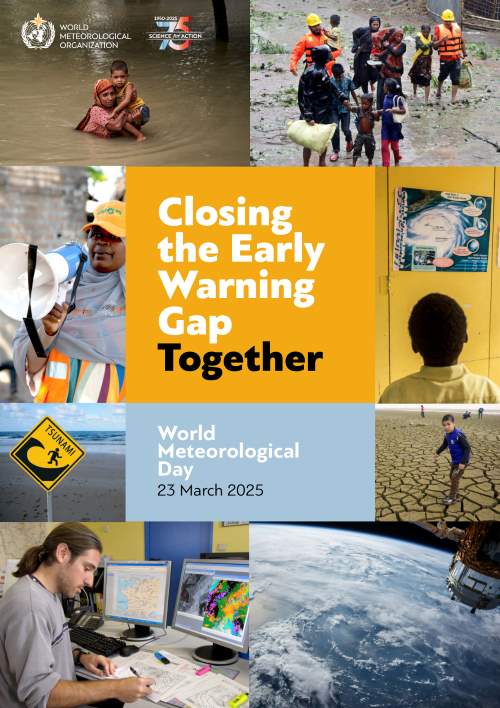As the world faces increasingly severe weather events, the role of meteorological science in protecting lives and livelihoods has never been more vital. This urgency is at the heart of this year’s World Meteorological Day, observed annually on 23 March.

The occasion not only celebrates the achievements of meteorological and hydrological services but also highlights the critical need to close gaps in early warning systems — an effort that has become a global priority.
This year’s theme, Closing the early warning gap together, reflects the growing demand for reliable forecasts in an era of rising climate risks. It also coincides with the 75th anniversary of the World Meteorological Organization (WMO) as a United Nations specialized agency, marking decades of progress in coordinating the global exchange of weather, climate, and hydrological data.
Since its founding, the WMO has played a pivotal role in transforming scientific knowledge into practical action, from guiding farmers on crop planning to informing billion-dollar infrastructure investments.
A changing climate, a growing need for warnings
The world is in the midst of a shifting climate reality. WMO recently confirmed that 2024 was the hottest year on record, continuing a trend of increasing global temperatures. Rising ocean heat, accelerating sea level rise, and the retreat of glaciers signal long-term changes that will shape the future. Meanwhile, extreme weather events — ranging from intensifying tropical cyclones and devastating floods to prolonged droughts and wildfires — are becoming more frequent and severe.
In this context, early warning systems have become essential. “The theme of this year’s World Meteorological Day – Closing the Early Warning Gap Together – reminds us that, in this new climate reality, early warning systems are not luxuries. They are necessities and sound investments – providing an almost ten-fold return,” said UN Secretary-General António Guterres.
Despite their proven benefits, nearly half the world’s countries still lack access to these life-saving systems. “It is disgraceful that, in a digital age, lives and livelihoods are being lost because people have no access to effective early warning systems,” Guterres added.
The role of meteorological services in global security
For decades, the WMO has worked to improve forecasting and early warning capabilities, helping nations prepare for and respond to climate and weather hazards. Every day, data is collected from a vast network of satellites, ground stations, weather balloons, ocean buoys, and aircraft. This information feeds into sophisticated prediction models, allowing meteorologists to issue timely warnings and advisories.
However, challenges remain. While technological advancements have improved forecasting accuracy, gaps persist in observation networks, climate data quality, and accessibility. Strengthening national meteorological and hydrological services (NMHSs), especially in developing nations, is critical—not only for local adaptation but for global resilience, security, and economic stability.
“The staff of National Meteorological and Hydrological Services are like doctors and nurses – working 24/7 to safeguard and promote public well-being,” said WMO Secretary-General Celeste Saulo.
Over the past 75 years, these efforts have saved countless lives and averted billions in economic losses. By enhancing forecasting capabilities, societies can better prepare for extreme events, reducing the devastation that follows.
Early warnings for all: progress and challenges
Between 1970 and 2021, weather, climate, and water hazards resulted in reported global economic losses of US$4.3 trillion and claimed more than two million lives. While financial costs continue to rise, early warning systems have helped reduce the human toll.
The UN’s Early Warnings for All initiative, launched to ensure universal early warning coverage by the end of 2027, is making steady progress. As of 2024, 108 countries reported having some capacity for multi-hazard early warning systems — more than doubling from 52 in 2015. This expansion demonstrates the potential of global cooperation, but much work remains to be done.
Advances in technology, particularly artificial intelligence (AI), offer opportunities to enhance forecasting. However, ensuring that every country benefits from these innovations requires greater investment, increased collaboration, and stronger political commitment.
“We need high-level political support for the Initiative within countries, a boost in technology support, greater collaboration between governments, businesses and communities, and a major effort to scale up finance. Increasing the lending capacity of the Multilateral Development Banks is key,” said Guterres.
Expanding global support
As climate risks intensify, efforts to expand early warning coverage are gaining momentum. The WMO and its partners are now broadening support beyond the initial 30 focus countries, working with donors, development banks, and climate funds to boost resources. Strengthening national meteorological agencies remains central to this effort, ensuring that warnings reach those who need them most.
The message on World Meteorological Day is clear: investing in early warning systems is not just about responding to disasters — it is about preventing their worst impacts before they unfold. By working together to scale up technology, foster collaboration, and mobilize resources, the world can take a decisive step toward a safer, more resilient future.
Article Source:
Press Release/Material by WMO
Featured image credit: Bhautik Patel | Unsplash




